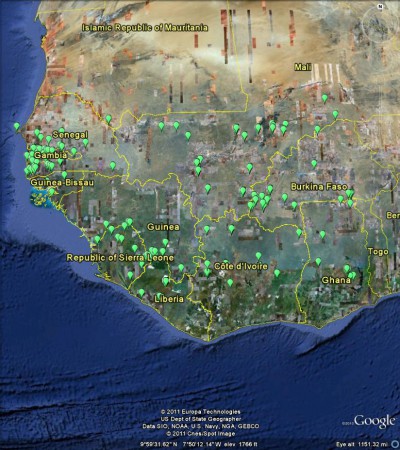Written, directed and produced by a former curator, Mike Jackson. Genebank videos could be a whole sub-category at the Oscars.
http://www.youtube.com/watch?v=e-j23qTjkGYJohn Innes’ peas on the BBC
The John Innes Centre announces on Facebook that, on the latest episode of the BBC2 programme Great British Food Revival, the Centre’s genebank curator, Mike Ambrose…
…talks to celebrity chef Ainsley Harriot about peas, and introduces him to the JIC collection of 3,500 types of pea. Available in the UK until 6:59PM Tue, 22 Nov 2011 (pea segment starts after 29 mins).
Alas, not available here in Italy. Can someone in the UK watch the pea segment and tell us about it, please? The JIC pea collection is one of the largest in the world.
LATER: Or, you can watch this: ((Thanks to whoever tweets for John Innes!))
http://www.youtube.com/watch?v=C6PSNMFV20kNibbles: Bangladeshi horticulture, USDA-ARS impact, NY native seeds, Spate irrigation, FIGS, Livestock trifecta
- The floating gardens of Bangladesh.
- So, USDA-ARS, what have you done for me lately?
- The story of Ed Toth, the director of New York City’s native plant center on Staten Island. In other news, New York City has a native plant center.
- Not all floods are bad.
- The Consortium discovers FIGS.
- Livestock genetic resources for the poor: The interview. And the PowerPoint. And the Fancy Science.
Getting one’s oats right
Luigi rapidly found me hundreds of accessions in genebanks around the world.
Alas, Luigi was looking for the wrong thing. As Axel Diederichsen succintly explains in a comment to Jeremy’s post of a couple of days back on naked oats.
The name Avena nuda L. refers to the small naked oat, a diploid species, while the naked oat talked about in this article is hexaploid and should rather be called Avena sativa subsp. nudisativa (with quotation of the authorities it will be: Avena sativa L. subsp. nudisativa (Husnot.) Rod. et Sold.). (Reference: Kobylyansky V.D. and Soldatov V.N. 1994. Flora of cultivated plants, vol. 2 part 3, Oat. Kolos, Moscow).
I had searched for Avena nuda, not Avena sativa subsp. nudisativa. Silly me. So it’s back to Genebank Database Hell for me. Needless to say, the subsp. nudisativa is unknown to any of the genebanks I checked, but that’s ok, because the hulless trait is a state in an official characterization descriptor for oats, and GRIN in both the USA and Canada allows a search on characterization descriptor states.
So now I know there are 375 hulless accessions in the US germplasm system and 262 in Canada, in both cases out of over 10,000 Avena sativa accessions. So my original statement turns out to be still true, though rather by luck than judgement. I know what you all want is a map of where those naked hexaploid oats come from, but that’s going to be really, really tricky until Genesys imports the oat characterization data.
AfricaRice’s African rice collection
Nice video. Note the reference, towards the end, to the systematic characterization of AfricaRice‘s collection of 2,500 Oryza glaberrima accessions. Interestingly, Genesys says the Centre has 3,796 accessions. I wonder what’s happened to the rest. Here’s a map of the 863 accessions from 129 sites with georeferences.
LATER: Compare with the map of African rice cultivation in Diana Buja’s post.
